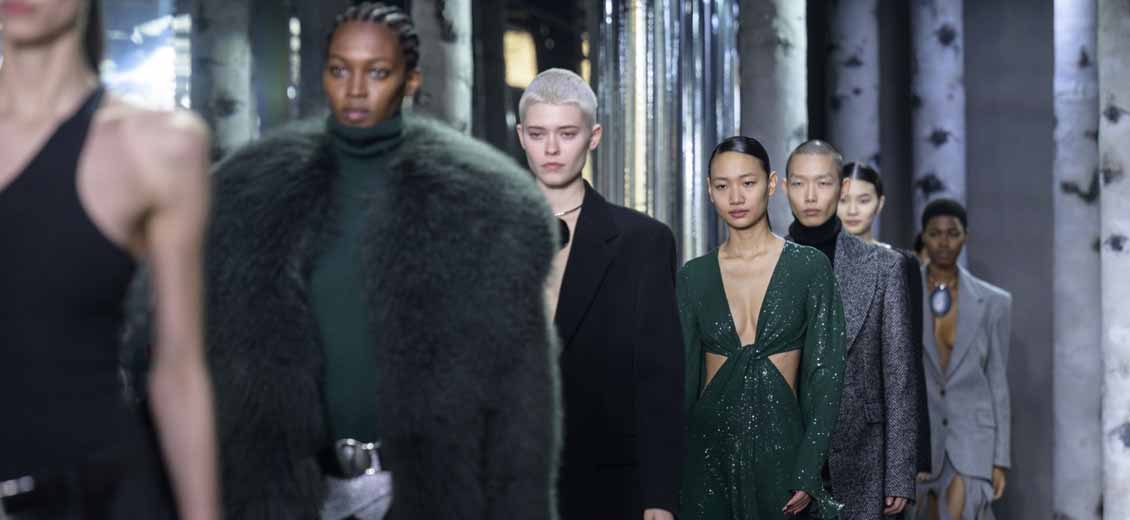From feminist icon Gloria Steinem at Michael Kors to trailblazing artist Eileen Gray at Gabriela Hearst, New York Fashion Week, which ended on Wednesday, showcased iconic women in fall-winter collections 2023.
The women who inspire Michael Kors
Nostalgic after a 42-year career, American designer Michael Kors set off to explore what inspired him “when (he) grew up in the 1970s”. First there is a place, the Greenwich Village neighborhood in New York, where the parade was held, once a “mix of glamor and bohemian”. And women of his generation, from Yoko Ono to Tina Turner, from Gloria Steinem to Jane Fonda, or even Aretha Franklin, whom he describes as follows: “They do not follow the rules, they follow their path and even if they are strong , powerful and intelligent, they are happy to love fashion.”
Journalist, author and activist, Gloria Steinem, 88, sat in the front row and the designer paid tribute to this feminist icon, also appreciated for her style, with a belt reminiscent of those she wore. The accessory looped back to enhance close-fitting dresses ending in fringes or a jumper set with mini-shorts and boots wrapped in a long coat.
“The ‘Awards’ season”, especially the Oscars, “is coming and we know we’re going to be bored because everyone will be wearing the same thing all the time”, he quipped. “The women you remember are wearing different outfits to parties, but it doesn’t have to be Instagram madness,” he added. On her catwalk, that meant a model walking the runway in a skin-tight sequined gold jumpsuit, under a long cashmere coat.
Gabriela Hearst apaise
The American-Uruguayan Gabriela Hearst continues to draw her inspiration from non-conformist, pioneering women who were often ignored or discredited during their lifetime. After the ancient Greek poet Sappho, one of the first feminists in history, for her previous collection, she highlighted on Tuesday the Irish artist and architect Eileen Gray, who had paved the way for the modernist movement in the 1920s.
The influence appears in the straight and functional cuts of jackets, trousers or long coats in recycled cashmere. A red bag or a very thin leather coat, formed like a puzzle of small symmetrical panels, directly recalls a work by the artist, who lived 98 years (1878-1976) and still holds the record for furniture from the XXe most expensive century at auction, an art deco dragon armchair sold for 21.9 million euros in 2009. “She never experienced ‘this success’ and like many women, she devalued and underestimated herself its excellence”, says Gabriela Hearst, who brings her brand to life while being artistic director at Chloé, in her collection note.
The fantasy remains imbued with sobriety, as with this ivory cable-knit sweater dress, entrusted to the “Manaus Del Uruguay” cooperative. The designer’s favorite colours, yellow gold, red and black, are also back, matched in stripes on a ruana (a type of poncho) and skirt set.
Beneath the folk music of the group Sumbuck, a feeling of calm prevailed, like the elegant and sober lines of the outfits of the models parading in a huge warehouse in Brooklyn.

The Nostalgic Blondes of Old Hollywood
Known for their sense of glam and extravagance, Philippe and David Blond, the couple and duo behind The Blonds, have tinged their collection with Hollywood references. Shimmering dresses, faux furs and chunky blow-dry or afro cuts on Louboutin stilettos blend with the soundtrack of a James Bond. “When we thought of old Hollywood glamour, the ultimate reference was Elizabeth Taylor, her tumultuous love affairs and her obsession with jewelry,” says David Blond backstage. On the catwalk, they translated the obsession with a diamond, worn as a jewel, an accessory at the level of the belt or even a protection for the whole upper body. A privilege returned to the transgender and black model and actress Dominique Jackson, known for her role in the series Pose on LGBTQ culture in black and Hispanic communities in New York in the 1980s and 1990s.
AFP

